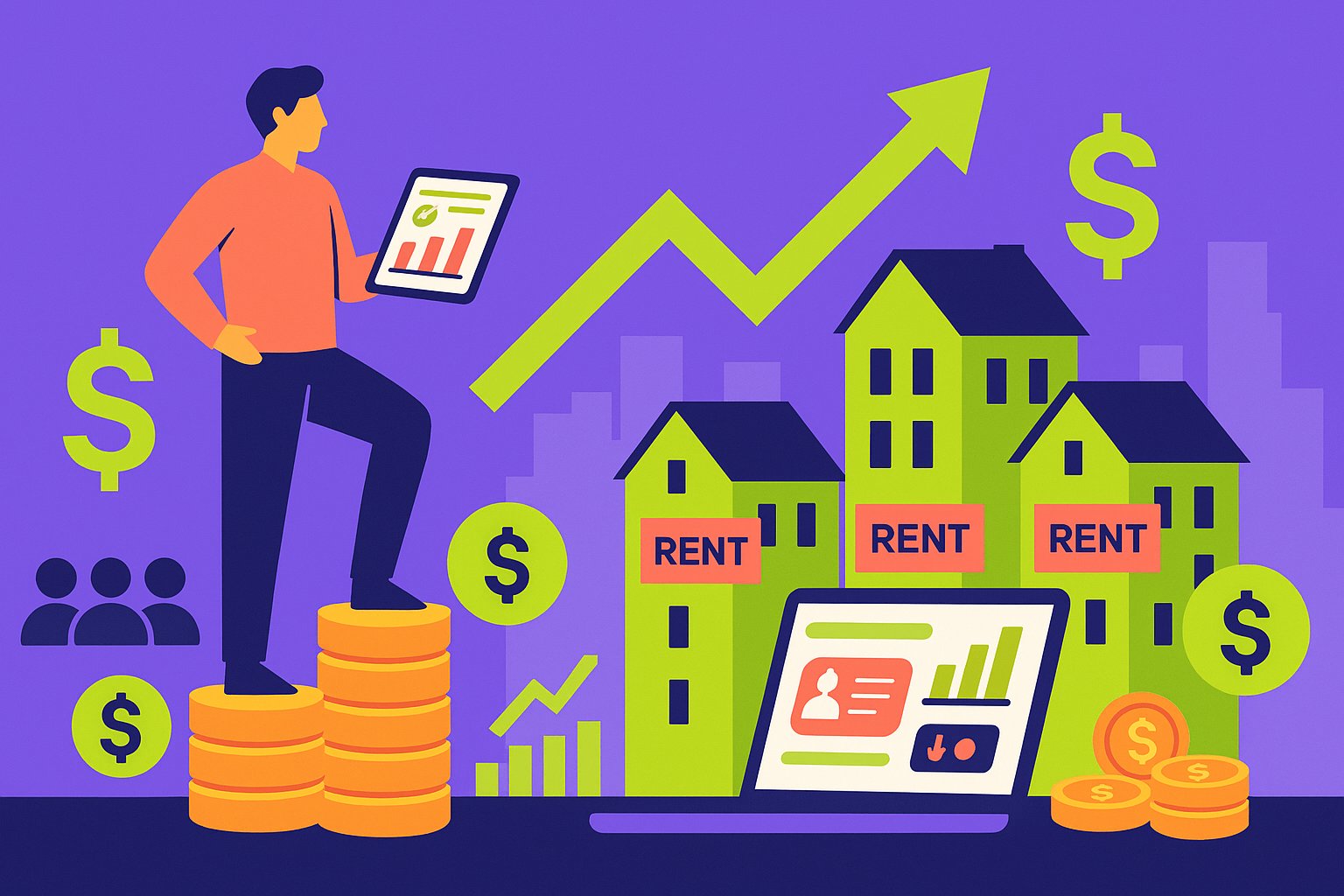Embarking on a New Era of Real Estate Investing
For passive investors craving steady cash flow and long-term growth, real estate crowdfunding platforms have rewritten the rulebook on property ownership. No longer must you juggle tenant phone calls, maintenance calls, or hefty down payments to access institutional-grade projects. Instead, digital marketplaces streamline deal sourcing, due diligence, and management, empowering individuals to pool capital and invest in a diversified range of residential and commercial properties. As this novel ecosystem proliferates, choosing the right platform becomes a pivotal decision—one that can shape your portfolio’s performance for years to come. In this guide, we’ll spotlight the top real estate crowdfunding platforms tailored to passive investors, unpack their unique value propositions, and offer insights into matching each platform’s strengths with your financial objectives.
Decoding the Essence of Passive Real Estate Crowdfunding
At its core, real estate crowdfunding dissolves traditional barriers to entry—high minimum investments, complex legal structures, and geographic limitations—by aggregating investor capital through online platforms. These digital portals vet sponsors, underwrite deals, and orchestrate property management, allowing you to bypass day-to-day landlord responsibilities. In many instances, you can participate with as little as $500, unlocking access to multi-family apartment complexes, mixed-use commercial properties, or debt-based bridge loans. Distributions arrive in the form of quarterly rental income or debt interest payments, while long-term appreciation generates capital gains upon project exit. This dual-income potential amplifies passive returns, offering a compelling alternative to REITs and traditional buy-and-hold rentals.
The democratization of real estate investing also broadens diversification opportunities. Rather than concentrating capital in a handful of local properties, crowdfunding allows you to spread investments across geographies, asset classes, and risk profiles. This mitigates the impact of regional market downturns and tenant vacancies on your overall cash flow. As these platforms evolve, they introduce innovative deal structures—preferred equity, mezzanine debt, and specialized niche sectors like student housing or senior living—further refining the passive investor’s toolkit. Understanding how each platform operates and differentiates itself is essential for constructing a resilient, income-generating portfolio.
Pinpointing the Pillars of Platform Evaluation
Before delving into individual platforms, it’s crucial to establish evaluation criteria that align with passive investing goals. First, assess minimum investment thresholds: platforms like Fundrise often allow entry points as low as $500, while others—C crowdStreet, for instance—may require $25,000 or more to access institutional-grade commercial offerings. Next, scrutinize fee structures; origination fees, asset management fees, and performance fees can erode net returns if not carefully balanced against projected yields. Evaluate historical track records: reputable platforms publish realized internal rates of return (IRRs) and equity multiples, providing insight into past performance. A thorough due diligence process also examines annualized cash-on-cash yields, average hold periods, and default rates in debt-based deals. Finally, consider platform transparency, technology integration, and secondary market capabilities, all of which underpin a seamless, data-driven experience for passive investors.
Fundrise: Pioneering E-REITs for Everyday Investors
Fundrise stands out as a pioneer in the crowdfunding arena, offering e-REITs and e-Funds that pool capital into diversified portfolios of residential and commercial properties. With a minimum investment of $500, Fundrise caters to both novice investors and seasoned real estate aficionados. The platform’s e-REITs—structured to emulate traditional REIT returns—distribute quarterly dividends derived from rental income, while also capturing appreciation through property value growth. What sets Fundrise apart is its emphasis on regionally focused real estate funds, allowing investors to select strategies targeting core markets, growth markets, or balanced approaches. Automated portfolio management features—such as auto-invest and reinvest—simplify the process, enabling passive capitalization of dividends to amplify compounding returns.
Transparency is another hallmark of Fundrise’s approach. Investors gain access to regular performance reports, asset-level due diligence materials, and detailed market analyses. Over the past decade, Fundrise has delivered average annualized returns in the mid-to-high single digits, a testament to its disciplined underwriting and diversified risk profile. While e-REITs lack daily liquidity, the platform’s optional redemption program—available under specific market conditions—provides a modicum of flexibility for rebalancing or accessing capital. As a long-term wealth-building vehicle, however, Fundrise excels in aligning passive investors with stabilized rental cash flows and moderate growth prospects.
RealtyMogul: Broadening the Spectrum with Diverse Deal Flow
RealtyMogul has emerged as a top-tier marketplace by offering a comprehensive suite of investment vehicles: individual property syndications, private REITs, and debt-based notes. With a minimum investment that ranges from $1,000 for private REITs to $25,000 for select private placements, RealtyMogul caters to a wide investor spectrum. The platform distinguishes itself through rigorous sponsor vetting and a curated selection of multi-family, self-storage, retail, and industrial assets. Investors can choose between MogulREIT I and MogulREIT II—each providing diversified exposure to income-producing properties in major metropolitan markets. For passive investors focused on steady cash flow, these REITs distribute monthly dividends derived from rental operations and property management fee rebates.
Beyond REITs, RealtyMogul’s private placements unlock institutional-grade deals—often off-market properties acquired at scale. These syndications span value-add apartment renovations, ground-up developments, and triple-net lease arrangements. RealtyMogul publishes historical IRR data, typical hold periods, and realized distributions, enabling investors to gauge past sponsor execution. Debt offerings catered to passive investors include short-term bridge loans that pay monthly interest, offering yields in the low to mid-teens. Whether seeking preservation of capital through first-lien debt or a blend of growth and income via equity syndications, RealtyMogul’s platform architecture accommodates myriad passive investing strategies.
CrowdStreet: Accessing Institutional-Grade Commercial Portfolios
For passive investors with heftier capital to deploy, CrowdStreet offers a doorway to institutional-grade commercial real estate—spanning office towers, industrial parks, and class-A apartment communities. With a typical minimum investment of $25,000, CrowdStreet’s marketplace emphasizes deal quality over sheer volume. Each offering undergoes stringent due diligence by the in-house CrowdStreet team, covering market studies, sponsor histories, financial projections, and exit strategies. Investors can participate in direct-property deals or choose diversified funds—such as the CrowdStreet Blended Portfolio—that allocate across multiple stabilized and value-add assets. Cash distributions typically arrive quarterly, mirroring the cadence of rental collection and debt service obligations.
Transparency and investor education are pillars of the CrowdStreet ethos. The platform provides interactive dashboards that display projected cash-on-cash yields, IRRs, and sensitivity analyses based on occupancy or rent fluctuations. Sponsors host detailed webinars to walk passive investors through underwriting assumptions, lease-up timelines, and renovation plans. By combining rigorous underwriting with a user-friendly interface, CrowdStreet empowers investors to navigate high-barrier commercial opportunities—historically reserved for institutional capital—without the operational headaches of direct ownership. While CrowdStreet’s high minimums may deter wallet-conscious investors, those seeking deep exposure to trophy assets and large-scale development projects will find the platform’s curated, sponsor-driven model appealing.
PeerStreet: Elevating Passive Income with Real Estate Debt
While many platforms focus on equity interests, PeerStreet carves out a niche by specializing in real estate-backed debt investments. With a minimum investment of $1,000, PeerStreet provides access to carefully underwritten bridge loans and financing secured by first-lien mortgages on residential and commercial properties. This debt-centric approach appeals to passive investors targeting predictable monthly interest payments and shorter hold periods—often ranging from six to twenty-four months. By eliminating exposure to equity volatility, PeerStreet’s model emphasizes principal protection, assuming careful sponsor underwriting and conservative loan-to-value ratios. Investors can browse loan offerings and select individual notes or opt for a fully managed “Auto Invest” portfolio to automatically allocate capital across multiple loans based on predefined risk criteria.
PeerStreet’s underwriting rigor distinguishes it from marketplace lenders with less stringent credit evaluation. Each loan undergoes meticulous property valuations, sponsor background checks, and analysis of borrower repayment capacity. Loan servicing—including payment collection, escrow management, and default mitigation—resides in-house, streamlining the cash distribution process for passive investors. Yields on PeerStreet’s debt offerings typically range from six to twelve percent annually, depending on property type, location, and loan-to-value ratios. By furnishing detailed loan performance metrics—such as historical delinquency rates, recovery percentages on liquidated loans, and average tenure—PeerStreet empowers investors to make data-driven decisions. For retirement-focused or risk-averse passive investors, the steady income and shorter commitment horizons provide an attractive complement to traditional equity-based crowdfunding strategies.
DiversyFund: Championing Growth Through Growth REITs
DiversyFund disrupts the crowdfunding space with its Growth REIT model, which zeroes in on value-add multifamily properties poised for renovation and rent appreciation. With a $500 minimum investment, DiversyFund democratizes participation in projects where sponsors purchase underperforming apartment communities, execute strategic refurbishments, and drive rental increases. Instead of distributing quarterly dividends, the Growth REIT retains all cash flow to reinvest in additional value-add acquisitions, compounding growth within the portfolio. Passive investors benefit from amplified equity appreciation upon eventual asset sales, often targeting an eight- to ten-year hold horizon to maximize capital gains. Although this buy-and-hold strategy yields deferred cash distributions, the focus on high-growth markets—such as Sun Belt metros with robust population influx—positions DiversyFund as a compelling vehicle for investors seeking long-term wealth accumulation.
Transparency is a core tenet of DiversyFund’s offering, with detailed quarterly reports on rent roll updates, renovation timelines, and value-add expenditures. The Growth REIT also provides a projected timeline for exit events, estimated equity multiples, and sensitivity analyses illustrating how rent growth scenarios impact overall returns. For passive investors seeking aggressive appreciation rather than immediate cash flow, DiversyFund’s model offers an alternative to dividend-focused REITs. By reinvesting net operating income back into new deals, the Growth REIT amplifies capital compounding—rewarding patient investors who align with the platform’s multi-year value-add vision.
Exploring Additional Notable Platforms
Beyond the five frontrunners, several specialized crowdfunding platforms cater to niche investor preferences. Roofstock One allows passive investors to acquire fractional interests in single-family rental properties across the United States, complete with professional property management and tenant placement. With a low entry point—often under $10,000—Roofstock One offers monthly distributions sourced from rent collection, tapping into a historically resilient asset class.
EquityMultiple focuses on high-end accredited investors, pairing them with seasoned sponsors in select markets. Its offerings span commercial equity, preferred equity, and senior debt investments, each accompanied by in-depth sponsor videos, property tours, and financial sensitivity analyses. Minimums typically start at $5,000 but can rise substantially for large-scale institutional deals.
Groundfloor provides a unique avenue for passive investors to fund short-term residential rehabilitation loans at minimums as low as $10. Its model emphasizes conservative loan-to-value ratios and short-term horizons—often six months—making it an attractive complement to longer-term equity-based strategies. By focusing on fix-and-flip projects, Groundfloor yields monthly interest distributions that align well with investors seeking rapid deployment cycles and consistent income streams.
Aligning Platforms with Your Passive Investing Blueprint
Selecting the right real estate crowdfunding platform hinges on crystal-clear financial objectives, risk tolerance, and desired time horizons. If steady quarterly dividends from stabilized portfolios appeal to you, Fundrise’s e-REITs or RealtyMogul’s private REITs may offer a harmonious blend of cash flow and moderate appreciation. For those seeking higher upside and willing to commit larger sums, CrowdStreet’s institutional-grade commercial offerings or DiversyFund’s Growth REIT can unlock fertile opportunities—albeit with longer hold periods. Investors who prioritize principal preservation and predictable returns might find PeerStreet’s debt notes or Groundfloor’s short-term bridge loans better aligned with their goals. Overlaying tax considerations—such as the pass-through benefits of K-1 entities and the depreciation shields in equity deals—further refines platform selection. By mapping your personal finance blueprint—cash flow needs, risk appetite, and desired liquidity—against each platform’s unique features, you can curate a hybrid portfolio that harmonizes diversified passive income with long-term capital growth.
Charting a Course for Sustainable Passive Income
As real estate crowdfunding continues its meteoric rise, passive investors enjoy unparalleled access to diversified portfolios, streamlined workflows, and transparent analytics—tools once reserved for institutional players. Yet amid the proliferation of platforms, discerning the top contenders remains paramount. From Fundrise’s trailblazing e-REITs to CrowdStreet’s trophy-grade commercial offerings, each marketplace brings distinct strengths to the table. By embracing rigorous due diligence—scrutinizing sponsor track records, underlying market fundamentals, and projected cash-on-cash yields—you position yourself to capitalize on high-quality opportunities. Moreover, integrating debt-based notes from PeerStreet or short-term bridge loans from Groundfloor can fortify your portfolio against market volatility, ensuring predictable passive income even during cyclical downturns.
Ultimately, maximizing your passive real estate returns hinges on disciplined diversification, technology-driven monitoring, and strategic reinvestment of distributions. As you navigate the evolving crowdfunding landscape, remember that long-term success is rarely achieved through a single deal or platform. Instead, adopt a holistic approach: blend equity and debt positions, diversify across regions and asset classes, and align tax strategies with your personal financial narrative. In doing so, you’ll not only unlock the promise of rental yields and asset appreciation but also cultivate a resilient, income-generating portfolio ready to thrive in any market environment. The future of passive real estate investing has arrived—and it’s time to stake your claim.




